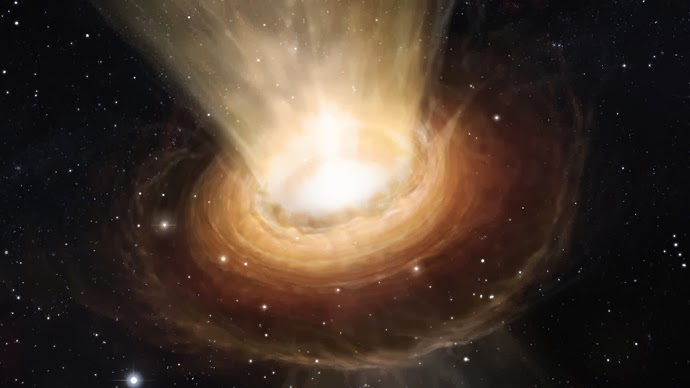Scientists have found the “clearest evidence yet” that the universe we inhabit is a giant hologram, paving the way towards reconciling one of physics’ most pressing issues: the relationship between Einstein’s theory of relativity and quantum physics.
In other words, we could be living inside a giant 3D projection of what is actually a two-dimensional space, similar to an IMAX movie theater screen or a painting. Or one could simply imagine the experience of looking at a three-dimensional object from various angles and seeing it change shape according to the point of observation.

Artist’s impression shows the surroundings of the supermassive black hole at the heart of the active galaxy NGC 3783 in the southern constellation of Centaurus (The Centaur) (AFP Photo)
The new experimental simulations proposed by Japanese scientist, Yoshifumi Hyakutake, and his team at the Ibaraki University of Japan tackle the varying energies of black holes discovered in parallel universes. But it also goes a long way towards marrying Einstein’s theory of general relativity and the theory of quantum mechanics as the two main theories describing our universe.
The findings were published in the journal, Nature, on December 10.
Quantum mechanics, on the other hand, deals with particle behavior on an infinitely small scale and therefore cannot belong in Einstein’s empirically testable worldview for the simple reason that it is too abstract and theoretical.
Though both suffer from certain inconsistencies: Einstein’s theory, for instance, breaks down when one imagines the middle of a black hole – an object in which time and space both collapse – the theories have been competing each other and generally hardly viewed as parallel. Scientists have been looking for a linking theory.
Hyakutake’s model explains some inconsistencies between the two big models, furthering the research first carried out in 1997. Then, theoretical physicist, Juan Maldacena, catapulted ‘string theory’ into the spotlight providing a reliable realization of the holographic principle.
Full Story: RT News
Related:
In other words, we could be living inside a giant 3D projection of what is actually a two-dimensional space, similar to an IMAX movie theater screen or a painting. Or one could simply imagine the experience of looking at a three-dimensional object from various angles and seeing it change shape according to the point of observation.

Artist’s impression shows the surroundings of the supermassive black hole at the heart of the active galaxy NGC 3783 in the southern constellation of Centaurus (The Centaur) (AFP Photo)
The new experimental simulations proposed by Japanese scientist, Yoshifumi Hyakutake, and his team at the Ibaraki University of Japan tackle the varying energies of black holes discovered in parallel universes. But it also goes a long way towards marrying Einstein’s theory of general relativity and the theory of quantum mechanics as the two main theories describing our universe.
The findings were published in the journal, Nature, on December 10.
In physics, the 'holographic principle' is a property described in string theory. It represents a volume of space whose entire information can be imagined as encoded on a boundary of that selected space. The holographic principle started by first observing black hole thermodynamics. There, it was noticed that the informational content of all the objects that got sucked in by the hole can be seen in a scaled sense on the hole's event horizon.Einstein, in his collective theorizing, posited that space and time are related and should be considered and calculated in relation to each other, and that the measurements of objects will be relative to the velocity of the person observing them. It is very empirical and observable.
Quantum mechanics, on the other hand, deals with particle behavior on an infinitely small scale and therefore cannot belong in Einstein’s empirically testable worldview for the simple reason that it is too abstract and theoretical.
Though both suffer from certain inconsistencies: Einstein’s theory, for instance, breaks down when one imagines the middle of a black hole – an object in which time and space both collapse – the theories have been competing each other and generally hardly viewed as parallel. Scientists have been looking for a linking theory.
Hyakutake’s model explains some inconsistencies between the two big models, furthering the research first carried out in 1997. Then, theoretical physicist, Juan Maldacena, catapulted ‘string theory’ into the spotlight providing a reliable realization of the holographic principle.
Full Story: RT News
Related:
- Physicists Find Evidence That The Universe Is A "Giant Brain"
- Quantum physics proves that there IS an afterlife, claims scientist
- Quantum Weirdness: What we call "reality" is just a state of mind
- Dr. Amit Goswami: Quantum Physics & Consciousness
- Nassim Haramein - Sacred Geometry and Unified Fields
- Anti-Gravity Ball by MIT Opens New Dimensions
Share on Facebook
Share on Twitter
Category:
Science



 This site's content is licensed under a
This site's content is licensed under a